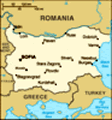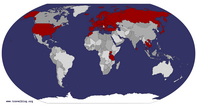Advertisement
Published: June 19th 2018
My hubby could have been a Palace Guard in Bulgaria once upon a time. Out of a whole group of tourists from UK, Canada, USA, Chile, South Korea, Russia, Australia and Spain, he was the only one who fitted the criteria to get this once well paid and illustrious job. All he had to do was catch an eagle and pluck a tail feather to wear in his hat and the job would have been his. What is this illusive criteria you ask? You just have to be blonde, blue-eyed and over 185 cms in height. However these days those rules are relaxed as there's not many blue-eyed blonde tall Bulgarians to choose from. Plus there's an eagle at the local zoo that supplies the feathers and the job is less prestigious with less pay. We were given these amazing facts plus more during a free walking tour around Sofia.
We had left the rain in Borovets to take the hour drive to Sofia, the capital of Bulgaria. We left the car at the park and ride in the James Bourchier Metro Station and walked into the city centre as it was only half an hour's journey.
The tour
met at the Palace of Justice and there were a lot of tourists, but luckily three guides to split us into smaller groups. Our guide, Stanislav was a very bubbly native of Sofia, a graduated actor who said he would get recognised a lot.... he didn't! But he was very amusing and interesting, taking us around the must see places whilst telling historical anecdotes.
There is a Royal Palace that is no longer Royal due to the communists removing all the contents. The penultimate King, Boris survived two assassination attempts, the second being a very clever plot where an important general was murdered and then the assassins bombed the funeral as hundreds of royals and dignitaries predictable attended. Boris survived because like most Bulgarians, was late. Being up to 20 minutes late here is the norm and not deemed rude. This would drive me nuts if I lived here!
The Palace Guards are now stationed in front of the presidency, coincidentally, the president is Boris' heir. So he still has a job.
It is allowed for the public to stand by the guards for photo ops, just so long as you get no closer than 2 metres.
If you break this rule, they are not allowed to shoot you, plus their guns are fake. However, I would not break the rules because in a nearby hut with mirrored windows are guards guarding the guards, with big automatic rifles and they will shoot you.
The once Royal Palace that is now an art gallery that is yellow in colour and the surrounding area has yellowed brick road. 98% of the population will proudly tell you that they were a gift from the Austro-Hungarian Empire to Tsar Ferdinand I to celebrate his wedding in 1893. However, the bricks weren't laid until 13 years later, so this story was highly suss. The bricks are a poor design and incredibly slippery, especially when wet and so there are minor roads accidents and people tumbling nearly every day. The authorities were too embarrassed to admit that they had borrowed money from a German bank to pay for the non durable ceramic bricks and that the loan would take 30 years to pay back. Thus the story was invented to keep the people from getting angry.
Stanislav told further anecdotes about various invasions, falling out with the Greeks over who had
the biggest church and mountain, communism and the statue of a very sexualised St Sophia that has no relevance to Bulgaria at all and annoyed local church leaders. However, this statue has replaced one of Lenin, so people soon got over the fact that it's pointless and now has become a well known landmark. We were told how even as recently as when Stanislav was a boy (he's in his mid 20's) going on the only escalator in Sofia was considered an exciting excursion. We also heard that 25% of the population would prefer communism to return, this demographic is the older part of the population. Their reasons being that there was free healthcare and education, plus there was no crime, needing only 2 policemen for 10 villages and the cost of living a lot cheaper. Sounds rosy to me - or rose coloured spectacles. I'm sure different people would remember differing pasts just like older people in the UK remember life before joining the EU. Stanislav loves that Bulgaria is part of the EU and for him, life is good. What was also good was the amount of tips he got at the end. I wonder if it's always
that good?
The tour ended up at Aleksandûr Nevski Memorial Church that was paid for by the people to celebrate their liberation from the Turks after 400 years. The name was chosen after a revered medieval Russian ruler, to thank the Russians for their help in over throwing the Ottoman Empire. The building is very impressive from the outside with great domes swathed in gold leaf that shone brightly in the sun. Photography inside costs 10 levs (£5) and I'm glad I didn't bother. It was a bit gloomy and as Glyn said, just lots of paintings of beardy old men.
After a cafe stop, we walked for half an hour in the hot sun to The Central Sofia Cemetery as recommended on blocal-travel.com. We had been expecting rain so didn't have hats or sun cream and ended up somewhat glowing at the end of the day. There was some shade in the overgrown cemetery that looked like it could disappear under the greenery within a few years. Some people were remembered with laminated a4 pictures stapled to the trees, many of the graves were just rows of drawers, but others were extremely extravagant, with images of the
deceased etched into the stone, or glazed into ceramic plaques. Many of the graves had benches and tables so that families could picnic with the departed. Disappointingly no cats here -I usually find some in cemeteries, but I did come across a kitten earlier.
A further 30 minute walk took us to the Hazdhi Dimitar neighbourhood, a district of tatty concrete blocks of flats in Soviet style, with huge paintings many floors high that were painted by local and international artists during an art festival in 2011. Despite being run down, the area felt safe with a good atmosphere as the locals soaked up the late afternoon sun on greens beneath the flats and parks. Cats chilled in the grass and dogs sat in roads. Kids played on rusty creaking playground equipment and the traffic is so polite. As soon as you think about crossing a road, the cars stop for you. There are zebra crossings with no lights on busy main carriageways and motorists stops without getting impatient. On the downside, pedestrians cross without looking and this can be irksome when driving.
Walking back to our car was a 75 minute journey so after half an hour
we caught the metro. There are just a couple of lines in Sofia and Glyn confidently bought tickets from the machine despite it being all in Bulgarian. I found the right platform and we changed at the right place. The carriages were so packed we didn't need to hold on, but there was aircon, so it wasn't unbearable.
Things had to go wrong at some point. At the metro where we left the car, we couldn't find the car park, let alone the car and no one could speak English. We knew it was connected, but there were no signs. Glyn showed our parking ticket to a lady in the train office to ask of the whereabouts, but she didn't understand. Then a local guy stepped in, despite not speaking English either. A lot of discussions were had and we were allowed back on the station through the disabled door. More discussions in Bulgarian were had as Glyn and I stood there being hopeless. Eventually the local guy walked us along a platform, up at the other end and asked another woman for help. She too appeared not to know either but they chatted a lot. After much anguish,
and riding a few escalators, a parking sign was eventually spotted and we were sent on our way. Now all we had to do was pay, but where were the pay machines or kiosk? The one by our car didn't work, so Glyn pressed the intercom and asked if anyone spoke English. The response was barked back in Bulgarian and abruptly silent. Ok. Searching other floors we could find no more machines so decided to just drive and see what happened. Navigating the tight concrete labyrinth, where cars are parked parallel to the walls (so that floor space was the opposite of utilised efficiently), we eventually came upon the exit and kiosk. Communication again was difficult until one guy took the parking ticket and a train ticket, charging 10 lev for the days parking. Cheap but was it worth it? We thought we would never leave Sofia!
Advertisement
Tot: 0.387s; Tpl: 0.016s; cc: 24; qc: 106; dbt: 0.1378s; 1; m:domysql w:travelblog (10.17.0.13); sld: 1;
; mem: 1.4mb













Dancing Dave
David Hooper
Sofia
We had three Bulgarians on our Tajikistan Pamir Roadtrip last August encouraging we visit Bulgaria. Your blog encourages...fascinating!